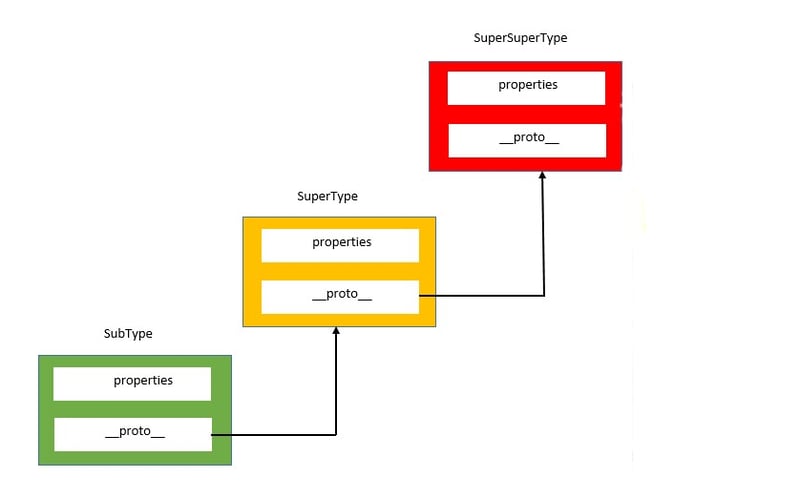Constructor Functions-
- In JavaScript, a constructor function is used to create objects.
- It is considered good practice to name constructor functions with an upper-case first letter.
Example-
Code-
const Phone = function (model, brand){
this.model = model,
this.brand = brand
}
phone.prototype.clickPicture = function(){
console.log(`${this.brand} ${this.model} clicks picture!`)
}
const iphone = new Phone("Iphone 12", "Apple")
console.log(iphone.clickPicture())
In the above example, function
Phone()is an object constructor function.To create an object from a constructor function, we use the
newkeyword.
Output-
"Apple Iphone 12 clicks picture!"
Built-in constructors-
Example-
let a = new Object(); // A new Object object
let b = new String(); // A new String object
let c = new Number(); // A new Number object
let d = new Boolean(); // A new Boolean object
- All these are constructor functions provided to us by javascript.
Code-
typeof Object
Output-
'function'
Classes-
- Another way of creating templates for JavaScript Objects are Classes.
- They are very similar to constructor functions. Classes have their own constructors that help initialize variables/values.
Constructor method-
The constructor method is a special method:
- It has to have the exact name "constructor"
- It is executed automatically when a new object is created
- It is used to initialize object properties
- If you do not define a constructor method, JavaScript will add an empty constructor method.
- Just like constructor functions, we can use the
newkeyword to create new objects from this class.
Example-
Code-
class Phone{
constructor(model, brand){
this.model = model
this.brand = brand
}
clickPicture() {
console.log(`${this.brand} ${this.model} clicks picture!`)
}
}
const iphone = new Phone("Iphone 12", "Apple")
console.log(iphone.brand)
console.log(iphone.clickPicture())
- Here
iphoneis an instance of the classPhone. - There is a reason why we do not call the
clickPicturefunction from inside the constructor because, the constructor is called every time we instantiate a new object and that would initialize the function every time instead of sharing it among objects thus taking up more space in memory.
Output-
"Apple"
"Apple Iphone 12 clicks picture!"
- Classes in JavaScript is just syntactical sugar but under the hood it still uses prototypal inheritance.
Inheritance in Classes-
Inheritance enables you to define a class that takes all the functionality from a parent class and allows you to add more. Using class inheritance, a class can inherit all the methods and properties of another class.
- The
super()method refers to the parent class.
 Credits- Rupesh Mishra
Credits- Rupesh Mishra
Example-
Code-
class Phone{
constructor(model, brand){
this.model = model
this.brand = brand
}
clickPicture() {
console.log(`${this.brand} ${this.model} clicks picture!`)
}
}
class Iphone extends Phone {
constructor(model, brand, software){
super(model, brand)
this.software = software
}
}
const tenPro = new Iphone("10 pro", "Apple", "IOS")
console.log(tenPro)
Output-
{
brand: "Apple",
model: "10 pro",
software: "IOS"
}
new keyword in JS
The new operator lets developers create an instance of a user-defined object type or of one of the built-in object types that has a constructor function.
Example-
Code-
function Car(make, model, year, owner) {
this.make = make;
this.model = model;
this.year = year;
this.owner = owner;
}
Output-
var car1 = new Car('Eagle', 'Talon TSi', 1993, rand);
var car2 = new Car('Nissan', '300ZX', 1992, ken);
Connect with me-
Appendix-
- Advanced JavaScript Series - Part 1: Behind the scenes (JavaScript Engine, ATS, Hidden Classes, Garbage Collection)
- Advanced JavaScript Series - Part 2: Execution Context and Call Stack
- Advanced JavaScript Series - Part 3: Weird JS behavior, Strict Mode and Hoisting, Temporal Dead Zone
- Advanced JavaScript Series - Part 4.1: Global, Function and Block Scope, Lexical vs Dynamic Scoping
- Advanced JavaScript Series - Part 4.2: Scope Chains and their working, Lexical and Variable Environments
- Advanced JavaScript Series - Part 5: IIFE & 'this' keyword in JS(tricky Eg.), call(), apply(), bind(), Currying(Functional Prog)
- Advanced JavaScript Series - Part 6.1: Everything in JS is an Object? Weird JS behaviors revealed, Primitive Non-Primitive Types
- Advanced JavaScript Series - Part 6.2: Pass by Value & Pass by Reference, Shallow & Deep Copy, Type Coercion
- Advanced JavaScript Series - Part 7: First Class Citizens & Higher Order Functions
- Advanced JavaScript Series - Part 8: The 2 Pillars~ Closures & Prototypal Inheritance
- Advanced JavaScript Series - Part 9: Constructor Functions, Object Oriented,
newkeyword
References-
- https://www.programiz.com/javascript/constructor-function
- https://www.w3schools.com/js/js_object_constructors.asp
- https://www.w3schools.com/js/js_class_intro.asp
- https://developer.mozilla.org/en-US/docs/Web/JavaScript/Reference/Operators/new
- https://www.programiz.com/javascript/inheritance
- https://www.w3schools.com/js/js_class_inheritance.asp







Top comments (0)